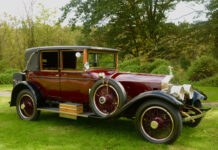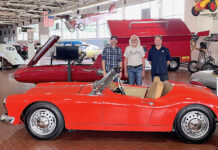By Jay Hirsch
The 1950 Oldsmobile was the second year of its post-WWII new-body design and the second year of the OHV Rocket V-8 engine. The Rocket V-8 engine, along with the OHV 331cid Cadillac engine, were the “Kings of the Roads” in the early 1950s. The Oldsmobile 88 with its Rocket 88 V-8 was the champ of the aspiring NASCAR stock car circuit. Cadillac, “the luxury car,” did not lower itself to race at stock car events.
The year 1949 not only saw a completely redesigned body style for Oldsmobile but also a new model, the two-door Holiday Coupe, also called a “hardtop convertible.” The car had no pillar between the front door and the rear passenger compartment. The front door looked the same as the front door on a convertible, there was no door frame around the window, as seen on the Rocket 88 here. When the front and rear windows were down there was nothing to obstruct one’s view, and the car has the open feel of a convertible. Buick and Cadillac also had similar hardtop convertibles beginning in 1949.
The “big” news for Oldsmobile was that Rocket 88 under the hood.
That OHV 303.7-cid/5-liter engine was standard on the 88 and 98 series and an option on the entry-level 76 series, which had the inline 6-cylinder/257-cid as its standard engine.
Hydramatic transmission, first introduced by Oldsmobile in 1939, was standard on the 88 and 98 series. The Hydramatic was premiered on the Oldsmobile, so that in case there were any problems with the transmission Cadillac’s image would not be tarnished. The Hydramatic was available for Cadillac in 1941.
The 1950 Oldsmobile seen here is a “true 1950s custom.” Ralph Scargogliero, the owner, has several cars from the mid-1930s to the late 1990s, some custom hot rods and other cars stock. The 88 Holiday Coupe is not exactly “stock!” Ralph bought the car 15 years ago from its third owner. He liked it because its was a true 1950s “custom rod.” The second owner was the one who did most of the work. The top was chopped seven inches, which still left plenty of headroom since the car was 64 inches in height when new, so that men could wear a hat when in the car. The door handles were taken off as well as the hood and trunk emblems and the holes filled with lead and then “smoothed.” The rear skirts were removed and the rear wheel opening on the rear fender was enlarged to the height of the rear tire and the opening was also rounded to go along with the shape of the tire. The chrome side trim was removed from the rear fender, and the chrome trim on the front fenders, which extended into the front door, was left in place. The grille on the Olds was left and today is a “rare item” as many owners of 1949–1951 custom Fords and Mercurys used the grills from 1949 and 1950 Oldsmobiles on their Fords and Mercurys.
The Olds was also lowered two inches, and the engine had two 4-bbls carburetors installed. The third owner replaced the Hydramatic with a floor mounted four-speed manual transmission and also repainted the car in red, which was the color the Olds was when new and was never any other color. The repaint was done in the 1990s as the original paint was starting to show its age in addition to stone chips and minor scratches over the years since the car was alway a “driver.”
When Ralph bought the car, the interior was showing some wear, and Ralph also wanted a front seat he could not only adjust forward and back, but up and down. Ralph found bucket seats and center console from an early 1970s Oldsmobile Cutlass and had the seats reupholstered in tan vinyl with matching tan trim on map pockets on the doors. Power was added to those bucket seats. Ralph installed the 14-inch tilt steering wheel and the “high stick” to the four-speed. The high stick was a trend with some hot rodders in the 1950s. Ralph’s is a “little higher than most” •



